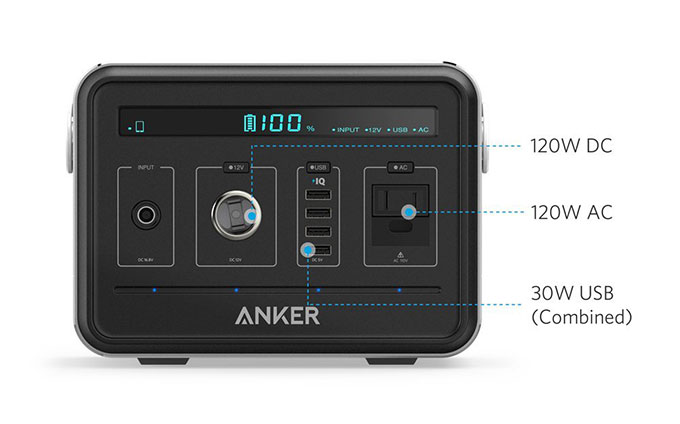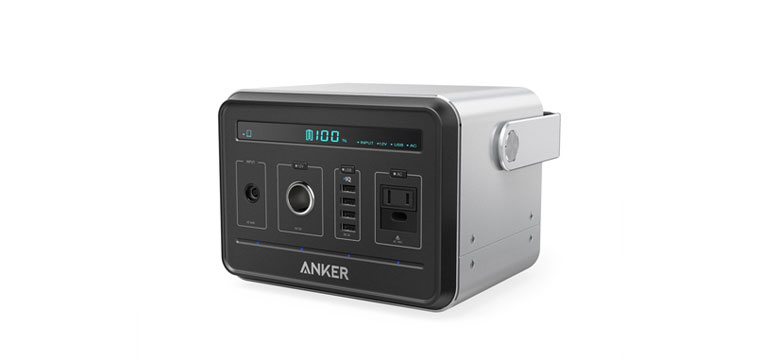-
Power
-
Portability
-
Features
-
Value
Summary
While not the most cheap option, the Anker PowerHouse 120,000mAh Portable Outlet certainly is a great alternative to a generator due to its ease of use, massive power capacity, and overall versatility.
- Gigantic capacity: more than forty charges for your phone
- Really versatile: can power devices from smartphones and laptops, to CPAP machines and mini fridges
- Can be operated by just about anyone due to its user friendly interface
- Quite heavy, not ideal to carry around
- Not many cables included, just a micro-USB cable and an AC charger
Since we’ve mainly been reviewing small portable power banks lately, we thought it was time for a change up for something new, by reviewing the gigantic capacity holding Anker PowerHouse 120,000mAh Portable Outlet. The PowerHouse is aimed at users looking for an alternative to a generator, and while it costs quite a bit, it brings some solid advantages over a regular generator. Let’s take a look at it in this review.
Design and portability
The Anker PowerHouse is rather big for something to be called portable. Measuring in at 7.87 inches in length, 6.5 inches in width and a thickness of 5.71 inches, it’s comparable in size to a car battery or a subwoofer. It’s also quite heavy. Weighing in at 9.26 pounds, the Anker Powerhouse is not something you can just take with you on a stroll or when taking a trip to the 7/11. Also, with such a huge capacity it’s not allowed for airplane travelling, as the limit for portable batteries to take on a flight stands at 100Wh. But then again, the Anker Powerhouse is not meant for people who will be occasionally using the device on the go. It’s made for serious use, like outdoor activity such as camping to hook up your mini fridge or portable stove, or for people using a CPAP machine at night. In which case it can be of tremendous help and—in these situations size or portability is not really an issue.
Anker has done a great job at designing the PowerHouse. Where most of Anker’s products can look quite a bit dull or borderline boring, the Anker PowerHouse 120,000mAh has a sleek silver metallic design with matte black finish on the front and backside of the unit. It’s fitted with a handle, making it—despite its heavy weight, relatively easy to move around. And although it’s made of plastic, the material feels very decent, bump resistant, and robust. Some users have opened up the unit to take a look inside of the goods. They’ve noted that the soldering is not excellent, but very decent for power bank standards.

A problem we see with most of Anker’s power banks is that the smoothness of the plastic makes it easy for the device to slip of surfaces. This time however we find that Anker placed rubber feet under the unit to give it a sturdy, solid grip on the surface it’s standing on.
Features & Power
Users who have opened the power bank have noted that the unit consists of thirty-six 3350mAh batteries (type 18650 cells), adding up to a total of 120,600mAh. So at least we know Anker is not inflating numbers. Which, let’s be real, a lot of power bank brands do.
A massive capacity of 120,000 (400Wh) is something we haven’t seen on a power bank before, but how many charges can it actually give your devices? Now you might think that it’s easy to calculate by just using the number 120,000 and dividing it by the capacity of your phone. However, this is not how it works. Some energy is always lost due to factors such as voltage conversion and heat. That said, check out this table to give you an overview and estimate of some devices you can charge with this powerhouse. Keep in mind that the stats below are an estimate and your mileage may vary. Also, battery capacities differ from device to device and some of the stats below are calculated by using an average.
| Device | Amount of charges |
|---|---|
| iPhone 7 | 45 charges |
| iPhone 7 Plus | 30 charges |
| Samsung Galaxy S7 / Samsung Galaxy S8 | 29 charges |
| Samsung Note 8 | 26 charges |
| Portable flashlight | 21 charges |
| Samsung Galaxy Tab 3 (10 inch) | 13 charges |
| Bluetooth speaker | 14 charges |
| Amazon Kindle | 11 charges |
| iPad Air | 10 charges |
| Macbook Air | 8 charges |
| Desk lamp | 100+ hours |
| Mini fridge | 7+ hours |
So, gigantic battery capacity aside, what can the Anker PowerHouse be used for? Let’s take a look at all the output ports of the Powerhouse.

12V DC Outlet (120W) – On the second of the left we find a 12V charging slot. Which you might recognize as the same charging port you find in a car. It can be used for a variety of things such as a car charger, GPS systems, and certain CPAP machines. The outlet is able to output 10 ampère, which translates to very quick charging rates.
4x USB output (30W) – The next row of slots we see are four USB charging ports rated at a maximum total output of 6 ampere at 5V (30W total). As you probably know already, USB ports can be used to charge a wide range of devices such as smartphones, tablets, portable speakers, wireless headphones, digital camera’s, portable flashlights, power banks and much more.
The ports do not support Quick Charge, but are equipped with Anker’s famed PowerIQ technology. Meaning they’ll safely charge your device with the most efficient amperage output and still provide you with a very rapid charge. An iPhone 7 is charged in under one hour and twenty minutes, and a Samsung Galaxy S7 is charged in one hour and forty minutes. Very comparable charging speeds to power banks such as the Anker PowerCore II 20000 and the Anker PowerCore II Slim 10000.
Each of the ports have a maximum output of 2.4A. However, when all USB slots are being used simultaneously, the maximum output per port is 1.5A. But to be fair, that’s still more than enough to charge most small devices at a very respectable rate.
110V AC Outlet (120W) – Last but not least, we find a regular AC outlet for the use of charging AC powered devices. It can be used to charge many small to medium sized devices such as a portable fridge, camping stove, laptop, sleep apnea CPAP machine, computer monitor and even TV’s. It has some great use cases. If for example you’re an avid outdoorsman or camper, you can use it to power up a camping stove and cook food. Or if you’re standing at a convention or trade show and need to power up a large LCD screen, you can simply plug it in the powerhouse and use it for hours on end. Furthermore, people with sleep apnea can use it to keep their CPAP machine charged throughout the night for up to three nights. The great advantage the PowerHouse has over using a generator here, is that the PowerHouse does not make any noise at all and doesn’t produce unsafe fumes.
It should be mentioned that the outlet tops out at 160W, meaning it will shut off if you try to use a device that needs more than 160W of power. Such as a microwave, hairdryer, toaster or coffee machine. Basically any device that produces heat or cooling will be too powerful for the outlet. Unless of course, the device is specifically made for the purpose of portable use, like a camping stove or mini fridge.
Since the voltage is 110V, the PowerHouse is meant for american use only. You can’t use it to convert to 220V. But then again, you’re not allowed to take it on an airplane to travel overseas anyway, so it’s not really an issue for most.
16-17V Input – You’d think a power bank of such humongous capacity takes a long time to recharge. However, the input of the power bank is a DC 16V/8A port. This means the PowerHouse will be charged in about five hours, which is extremely impressive. For comparison, it recharges just as fast as a 10,000mAh power bank being charged with a 2A adapter.
Anker recommends to charge the device at least once every four months to retain its power and keep it from losing efficiency. They also mention it can be used in unison with the Anker 21W Solar Charger to charge the PowerHouse with solar power. However, it will take a ridiculous amount of time to fully charge the portable outlet with the solar charger, so I personally don’t really see the point of it that much.
To make everything just a bit easier, Anker provided the unit with a proper sized LCD display panel, so you can see exactly how many hours of power you have left in the power bank, and to see which of the ports you are using at the moment. There’s buttons above all the charging ports, which you have to press to tell the power bank that you’ll be using that particular charging port, after which it shows an indicator on the screen that the slot is being provided with power now.
The interface makes the PowerHouse a very user friendly device, especially compared to actual generators. It does not require any technical knowledge of electrical engineering and can be used by just about anyone.
Conclusion
The Anker PowerHouse 120,000 mAh certainly lives up to his name, but is it actually useful for most? The simple answer to that is: no, for most people, it’s not really a practival device. Most people don’t want to be carrying around a nine-and-a-half pounds bulky unit. But for people who need an alternative to a generator, the Anker Powerhouse 120,000mAh is a fantastic option. It’s a great device for people who stay outdoors for long periods, and also for people who suffer from sleep apnea to portably keep their CPAP machine powered throughout the night. All in all, the Anker PowerHouse 120,000mAh Portable Outlet—although quite costly, is an incredibly versatile device with lots of use cases, a solid efficiency, a sturdy built, and is backed by a whopping 18-month warranty from Anker.
Check prices on AmazonTechnical Specifications
| Measurements: | 6.5 x 7.87 x 5.71 inches |
| 165 x 200 x 145 mm | |
| Weight: | 9.26 lbs (4.2 kg) |
| Charging ports: | 1x 12V/10A DC outlet (120W) |
| 4x 5V/2.4A USB outputs (30W max) | |
| 1x 110V/1.36A AC outlet (120W) | |
| Safety features: | Battery management system (Temperature control, voltage control and more) |
| Compatible with: | iPhone, Android, tablet, laptop, camping stove, CPAP machine and more |
| Pass-through charging: | Yes (through USB ports only) |
| Smartports: | Yes (PowerIQ) |
| Qualcomm Quick Charge: | No |
| Battery indication: | LCD display panel |
| Flashlight: | No |
| Battery capacity: | 120,000 mAh (400Wh) |
| Total max output (DC): | 10A (120W) |
| Total max output (USB): | 6A (30W) |
| Total max output (AC): | 1.36A (120W) |
| Input: | 16-17V/8A |
| Time to charge itself: | 5 hours |
